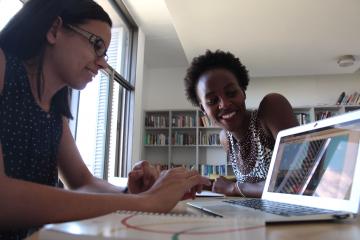
Using evidence to effectively support education during COVID-19

This blog was originally posted on The Center for Effective Philanthropy.
In light of school closures caused by COVID-19, millions of students are home for the remainder of the academic year. Philanthropy will play a vital role in the response to this crisis. But how can education funders and donors ensure that they are allocating their resources effectively?
At a time when quick action is necessary, rigorous evidence can cut through the noise and guide effective giving strategies. By making evidence-informed decisions, funders can be confident in the efficacy of the programs they fund. To aid funders in this process, the education team at J-PAL North America compiled a list of rigorous evidence-informed recommendations, based largely on randomized controlled trials, for effectively supporting K-12 education during this crisis.
1. Expand access to technology
As students turn to online learning, disparities in access to technology are exacerbating pre-existing achievement gaps and inequities between high- and low-income students. In 2017, approximately 7 million school-age children in the United States lacked internet at home. Students who lack access to essential technologies will be unable to engage in many virtual learning opportunities.
There are several ways funders can take action to combat this risk. For example, funders can provide school districts serving low-income students with laptops and tablets. While evidence suggests that expanding access to technology alone typically does not improve learning outcomes, providing students with these essential tools during the pandemic is critical to enable online learning. If possible, tablets and laptops should be pre-loaded with educational applications, and programs that can run without internet should be prioritized.
Funders can also work with school districts to expand internet connectivity in their region. In a remote learning landscape, students require internet to connect with their instructors and access online resources. In addition to partnerships with internet providers, donors should consider supporting districts to expand connectivity through smartphone distribution or other innovative means. In Texas, for example, one district equipped 110 school buses with WiFi to be parked in neighborhoods with low connectivity.
2. Support evidence-based programs that help parents and guardians
Many parents and caregivers must now also serve as educators. Evidence suggests that short, actionable directions for engaging activities can better equip parents to support student learning at home. Many companies implementing digital family-engagement interventions, like Ready4K and TalkingPoints, are offering free programming during closures, and have seen overwhelming demand. To expand access to these interventions, donors can provide financial support to companies offering free, evidence-informed behavioral interventions to support parents as educators.
3. Expand effective programming
Research consistently points to Computer-Assisted Learning (CAL) programs — programs that enable students to engage with educational materials through digital software — as a promising form of education technology. Effective CAL programs typically encourage self-paced learning, provide tailored feedback, and share data with instructors to track student progress. Even with relatively light usage, CAL programs can produce non-trivial learning gains. They can be part of structured remote curriculum, like ASSISTments, or used independently, like Khan Academy.
While many CAL and tutoring programs are effective, funders can maximize their impact by making an effort to identify and support accessible CAL programs that mimic a tutor. Funders should look to support programs that are self-paced and provide real-time feedback. Programs that are free, phone-compatible, and functional offline will most effectively reach students with limited technology and internet access. Funders should also encourage grantees to develop onboarding resources, as research suggests that CAL is most effective with guidance on proper usage.
Tutoring programs have also consistently generated promising academic gains for students. Funders can also support effective tutoring programs in their virtual operations and provide funding to expand tutoring programming when schools reopen. Many tutoring programs have shifted online to continue to support students during closures. Saga Education is an organization currently offering virtual tutoring in New York City at no cost, as the school district is unable to fund the programming. While their virtual tutoring has not been evaluated, evaluations of Saga’s in-school model have pointed to impressive academic gains, with students gaining 2.5 years of math in one school year. Funders should consider covering organizational costs for effective tutoring programs so that students can continue to receive personalized supports during school closures.
Organizations with proven methods of helping students catch up will also be crucial once schools reopen. Funding effective tutoring organizations to expand their operations when schools reopen will help mitigate the widening achievement gap that is likely to occur during closures.
4. Understand the impact of COVID-19
Though postponed state academic testing will delay the ability to discern the impact of school closures on learning, research to understand student progress and engagement during closures can start now. Using data from education technology platforms, researchers and educators can identify students who are not engaging with online learning and reach out with targeted supports. Researchers can use administrative data to support service delivery for students, such as ensuring that students with free or reduced-priced lunch continue to receive meals during school shutdowns.
We recommend that funders provide support for researchers and districts to start data collection and expand learning management systems. Supporting researchers and districts in data collection and learning management now can both jumpstart our understanding of how this crisis is impacting students and lead to the development of solutions to support students who are falling behind.
Turning to rigorous evidence during the COVID-19 crisis can ensure that funders invest in programs that work. J-PAL staff are happy to discuss existing evidence, connect donors to academic researchers, or facilitate introductions between donors and education organizations running effective programs.



